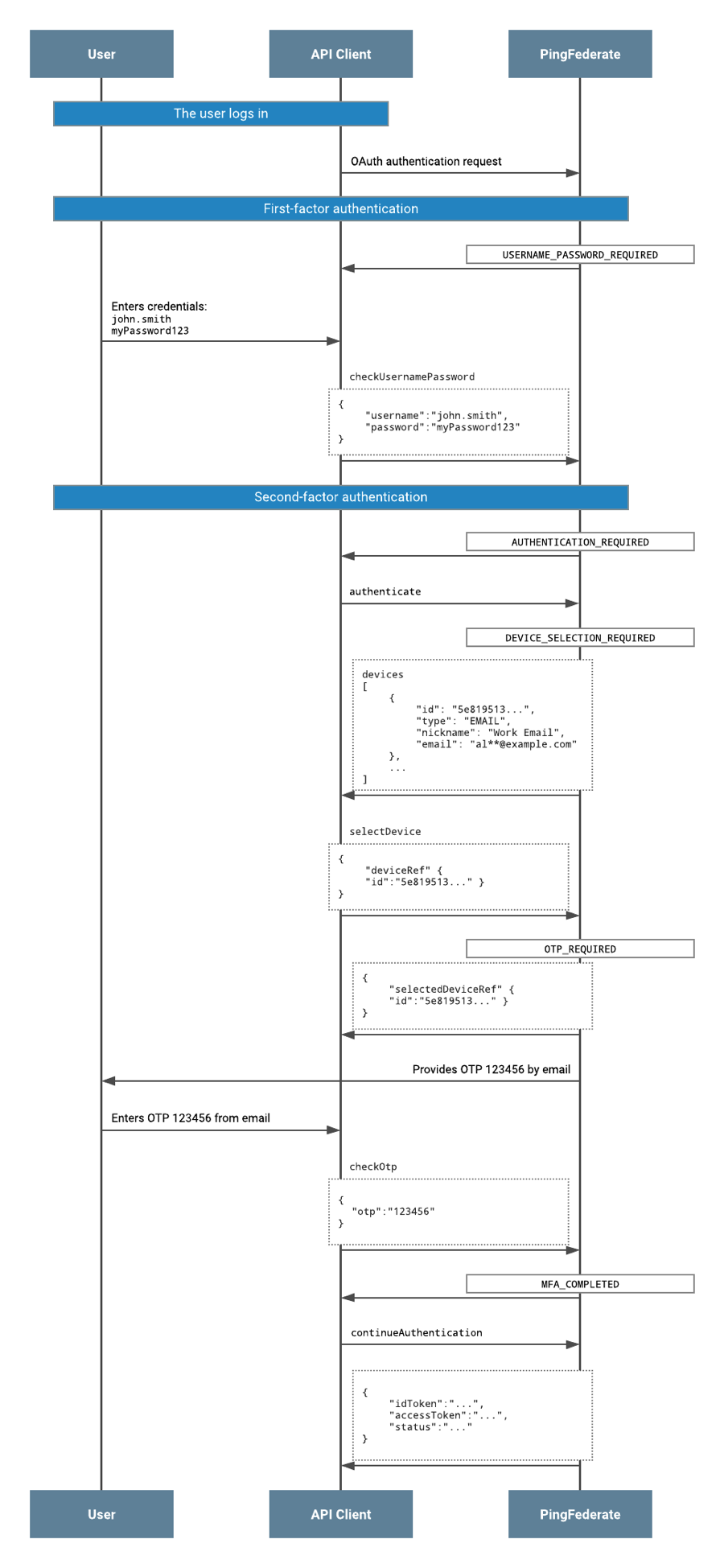Authentication flows
When using the PingOne MFA IdP Adapter through the PingFederate authentication application programming interface (API), the following flows are used for multi-factor authentication (MFA) requests. These are initiated in the web browser.
MFA via email

-
The user completes first-factor authentication. Completion of first-factor authentication is a prerequisite before progressing to MFA, when using the PingOne MFA IdP Adapter with the PingFederate Authentication API flow.
-
The status of
AUTHENTICATION_REQUIREDis returned in the response to the API client. -
The API client invokes the
authenticateaction. -
The status of
DEVICE_SELECTION_REQUIREDis returned with the devices object in the response to the API client. -
The API client invokes
selectDeviceaction and specifies the device ID of the device to use for MFA. -
The status of
OTP_REQUIRED, together with the devices andselectedDeviceRefobject, are returned in the response to the API client. In parallel, the user receives an email containing the one-time passcode (OTP) for authentication. -
After the user has entered the OTP, the API client invokes the
checkOtpaction, submitting the OTP value to PingFederate. -
On successful completion of MFA, PingFederate returns the status of
MFA_COMPLETEDto the API client. -
The API client invokes the
continueAuthenticationaction. The API client must callcontinueAuthenticationin order to progress in the OIDC flow, and to complete it. -
PingFederate returns a single sign-on (SSO) ID token and access token to the API client.
MFA via the mobile app

-
The user completes first-factor authentication. Completion of first-factor authentication is a prerequisite before progressing to MFA, when using the PingOne MFA IdP Adapter with the PingFederate Authentication API flow.
-
The status of
AUTHENTICATION_REQUIREDis returned in the response to the API client. -
The API client invokes the
authenticateaction. -
The status of
DEVICE_SELECTION_REQUIREDis returned with the devices object in the response to the API client. -
The API client invokes
selectDeviceaction and specifies the device ID of device to use for multi-factor authentication. -
The status of
PUSH_CONFIRMATION_WAITING, together with the devices andselectedDeviceRefobject, are returned in the response to the API client. -
The API client invokes the
pollaction, so that PingFederate gets the status of the mobile push. This is repeated until either a successful status is received or a timeout is reached. -
One of the following alternative statuses is reached:
-
MFA_COMPLETED:-
The user receives a push notification and approves the authentication.
-
The API client invokes the
continueAuthenticationaction. The API client must callcontinueAuthenticationin order to progress in the OIDC flow, and to complete it. -
PingFederate returns an access token for SSO, to the API client.
-
-
PUSH_CONFIRMATION_TIMED_OUT:-
The device was not reachable.
-
There are three options available via the API client:
-
Retry by calling
selectDevicewith thedeviceRefobject. -
Select a different device by calling
selectDevicewith a differentdeviceRefobject. -
Cancel the authentication request by calling
cancelAuthentication.
-
-
-
PUSH_CONFIRMATION_REJECTED:-
The user receives a push notification, but denies it.
-
There are three options available via the API client:
-
Retry by calling
selectDevicewith thedeviceRefobject. -
Select a different device by calling
selectDevicewith a differentdeviceRefobject. -
Cancel the authentication request by calling
cancelAuthentication.
-
-
-